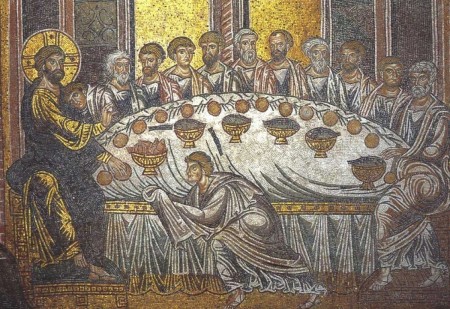Jesus is anointed at and ascends from the house of the poor

We've looked at the incident in which Judas criticized Mary for anointing Jesus with expensive perfume. We saw that Judas feigned a concern for the poor. Taking geographical context into account we see the extent of his arrogance. The scene takes place in the town of Bethany, the name of which is likely based on the Hebrew words for "house" and "poor."
Going as far back as the ancient Church historian Eusebius, Bethany has been translated as 'House of the Poor'. Some scholars argue that the Jewish monastic group, the Essenes, founded communities for the poor, lepers, and other outcasts in Bethany.
This is consistent with the fact that the dinner occurs at the house of "Simon the leper." Bethany is a place where Jesus spent a fair amount of time and where he had friends. Jesus was a friend of the poor, sitting at a table in the House of the Poor, being lectured about the poor by a man who loved money. The Pharisees loved money, but also spoke disparagingly of it. Talking up poverty and talking down wealth can easily be a cover for greed, a deflection of attention away from a racket.
But Jesus was literally a friend to the poor, or more precisely, not to "the poor" as an abstraction, but to actual friends from a poor town. This is the place where Jesus gets the anointing for his death. Bethany (where Lazarus lived) was quite near to Jerusalem, on its very doorstep, as fictionalized in the story of Lazarus and the Rich Man (who is almost certainly the High Priest) (The Parable of Lazarus and the Rich Man – Theopolis Institute).
Bethany, the home of the poor and of lepers, sits almost on the very front porch of Jerusalem of the High Priest. This story is drenched in economic factors. The resurrection of Lazarus was causing people to move towards the cause of Jesus, and on that basis the temple elite wanted to kill him and to kill Jesus. The high priest argues for this by appealing to the fear that they "will lose their place" -- that is, lose their place in the social and economic hierarchy.
Jesus is a threat to their livelihood, and the raising of Lazarus is a trigger for this. Jesus disrupts their economic model, and Lazarus is the proof of that. He heals. He cleanses. He forgives sins. He receives the sacrifice of praise and thanksgiving. Who needs the Temple? Jesus makes it obsolete by being a better temple, one that is torn down but is built back up in three days. The stone temple is torn down and not rebuilt.
On the other side of the murder and then the resurrection of Jesus, we have Jesus' ascension, which takes place in or near, yes, Bethany.
"And He led them out as far as Bethany, and He lifted up His hands and blessed them.
(Lk. 24:50-51 NAS)
And it came about that while He was blessing them, He parted from them."
Jesus could have ascended from Jerusalem. That's what someone who bought into the social status hierarchy of the system would have expected, just as the Magi expected that he would touch down in Jerusalem. But he ascends from the house of the poor. He hangs with the poor. He raises someone from that region from the dead.
How in the world could Judas (and even the other disciples) complain? Lazarus' sister gave less than a year's wages worth of perfume, but Jesus gave Lazarus added years of life. Jesus had more than done right by the people of Bethany. The poor weren't an abstraction to Jesus, nor a grift, but a community -- and a poor town was the last place on which his feet stood on earth.
Jesus is what Judas claims to be, one who can be trusted to hold the combined wealth of the world and distribute its riches to the poor, a true shepherd and not a hireling.
Jerry Bowyer is financial economist, president of Bowyer Research, and author of “The Maker Versus the Takers: What Jesus Really Said About Social Justice and Economics.”





















